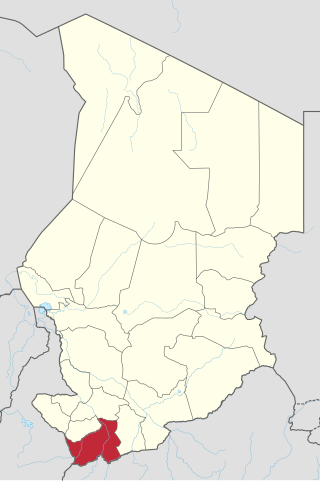Related Research Articles
The Fer language, also Dam Fer or Fertit, one of several languages called Kara, is a Central Sudanic language spoken by some five thousand people in the northern Central African Republic near the Sudanese and Chadian borders, in the region known as Dar Runga.
The Sara languages comprise over a dozen Bongo–Bagirmi languages spoken mainly in Chad; a few are also spoken in the north of the Central African Republic. They are members of the Central Sudanic language family. Greenberg (1966) treats all varieties as dialects of a Sara language, whereas Tucker and Bryan (1966) consider the Sara to be a dialect cluster of several languages. Most members of the different Sara languages/dialects consider their speech form distinct languages, but there is currently insufficient language information to determine which speech varieties need to be considered distinct languages, and which are dialects of other languages.

Mandoul is one of the 23 regions of Chad. Located in the south of the country, it comprises part of the former prefecture of Moyen-Chari. The regional capital is Koumra.

Logone Oriental is one of the 23 regions of Chad, located in the south-west of the country. Its capital is Doba. It is coterminous with the former Logone Oriental Prefecture.
Mpadə is an Afro-Asiatic language spoken in northern Cameroon and southwestern Chad. Dialects are Bodo, Biamo, Digam, Mpade (Makari), Shoe (Shewe), and Woulki.
Miltu is an endangered Afro-Asiatic language spoken in southwestern Chad, in villages along the Chari River in the area of Bousso. A 1993 census reported 270 speakers. Speakers are shifting to Bagirmi.
Tumak, also known as Toumak, Tumag, Tummok, Sara Toumak, Tumac, and Dije, is an Afro-Asiatic language spoken in the southwestern Chadian prefectures of Moyen-Chari and Koumra. Motun (Mod) and Tumak dialects have a lexical similarity of only 70%; Blench (2006) lists Tumak, Motun, and Mawer as separate languages. Most Motun speakers use some Sara.
Ngambay is one of the major languages spoken by Sara people in southwestern Chad, northeastern Cameroon and eastern Nigeria, with about a million native speakers. Ngambay is the most widely spoken of the Sara languages, and is used as a trade language between speakers of other dialects. It is spoken by the Sara Gambai people.
The Bongo–Bagirmi or Sara–Bongo–Bagirmi (SBB) languages are the major branch of the Central Sudanic language family with about forty languages. Principal groups include Bagirmi languages such as Naba and the Sara languages. They are spoken across CAR, Chad, South Sudan, Sudan and adjacent countries.
Kaba proper is a Bongo–Bagirmi language of Chad and the Central African Republic. It is one of several local languages that go by the names Kaba and Sara. There are three ISO codes, which Ethnologue acknowledges may be the same thing.
Kaba Démé, or just Dem, is a Bongo–Bagirmi language of Chad and the Central African Republic. It is one of several local languages that go by the names Kaba and Sara.
Kaba (Kabba), or Kabba of Goré, is a language of the Sara people in Central African Republic and Chad, with around 100,000 speakers.
Mbay, or Sara Mbay, is a Bongo–Bagirmi language of Chad and the Central African Republic.
Ngam, or Sara Ngam, is a Bongo–Bagirmi language of Chad and the Central African Republic.
Sar or Sara, also known as Madjingay and Sara Madjingay is a Bongo–Bagirmi language of southern Chad, and the lingua franca of regional capital of Sarh.
Kaba So, also known as Kulfa after its primary dialect, is a Bongo–Bagirmi language of Chad. It is nearly intelligible with Kaba Na, which is used as a second language.
Beraku is an extinct Bongo–Bagirmi language of Chad. Speakers have shifted to Chadian Arabic or various Kotoko languages.
Laka, also known as Kabba Laka, is one of the Sara languages of Chad.
Gula is a Bongo–Bagirmi language of Chad.
Morom, also known as Bernde, is a Bongo–Bagirmi language of Chad.
References
- The Sara-Bagirmi Language Project -- Mango
- The Sara-Bagirmi Language Project -- Gor
- The Sara-Bagirmi Language Project -- Bebote
- ↑ Bedjond (Nangnda) at Ethnologue (18th ed., 2015) (subscription required)
Mango at Ethnologue (18th ed., 2015) (subscription required)
Gor at Ethnologue (18th ed., 2015) (subscription required) - ↑ Isaac, Kendall; Johnson, Eric C. (2007). A sociolinguistic survey of the language varieties of the Doba area of Chad: Bebot, Bedjond, Gor, and Mango. SIL.